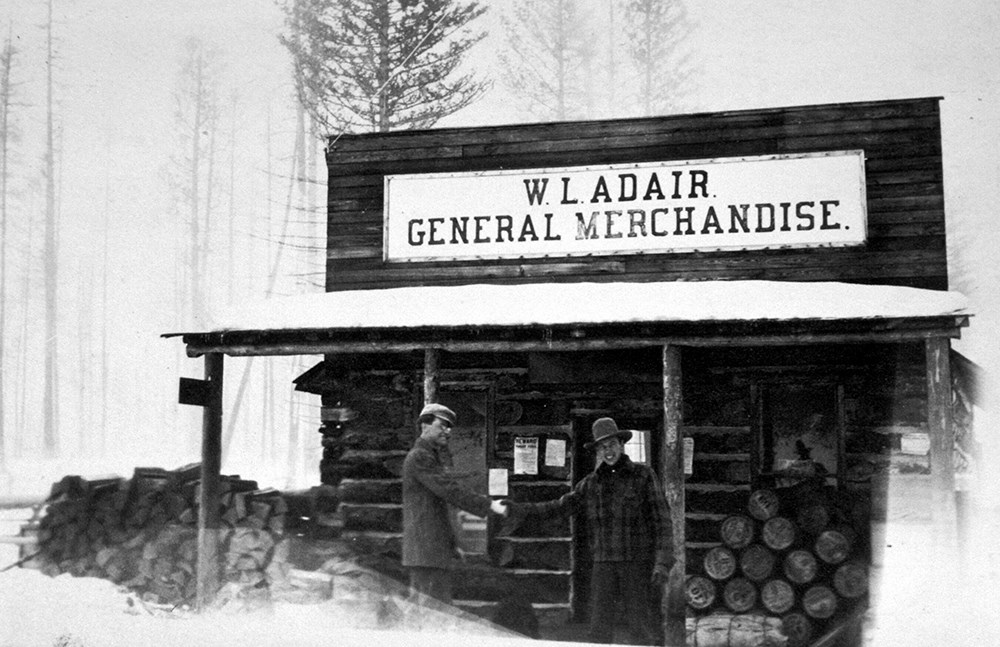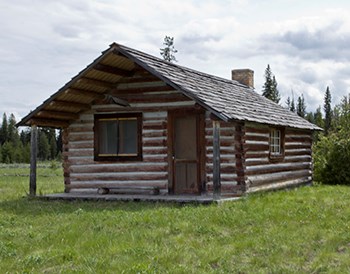Last updated: February 2, 2021
Article
North Fork Homesteads Resource Brief
Background Information

NPS Archive
Importance
It’s important to the park and its visitors that the history of the North Fork settlers is not forgotten. Although many of the structures are afforded some protection as historic places, fire can erase some of these old homesteads. The 1988 Red Bench Fire destroyed three of the listed homesteads. The historical and archeological research documenting the personalities and lifeways of these pioneers now informs interpretive exhibits and programs offered to park visitors. One recently installed exhibit, located at the site of the original Jeremiah and Margaret McCarthy cabin, highlights the experience of the McCarthy’s and other adventurous homesteaders who once called the North Fork home. Hopefully by understanding the lives and dreams of those that once met the challenge of life in the wilderness, contemporary park visitors will be inspired to support and appreciate the long-term preservation and stewardship of these rare historic resources.
The North Fork Valley attracted pioneers well before the establishment of Glacier National Park. With abundant wildlife, minerals, timber, fresh water, and the potential of coal and oil, the North Fork Valley experienced rapid development in the late 1800s. In 1893, the Great Northern Railway completed its transcontinental line from St. Paul, Minnesota to the West Coast via Marias Pass, providing a nearby connection for the settlers of the North Fork Valley to sell resources to a national market. The discovery of oil seeps around Kintla Lake prompted the Butte Oil Company to clear a 40-mile wagon road (now the inside North Fork Road) through the forest in 1901.
Although this ungraded, stump-ridden, wagon road was difficult to travel, it encouraged settlement on the east side of the Flathead River. In 1904, William Adair opened a mercantile on the new road in Sullivan Meadow, south of Logging Creek. By 1910, 44 homesteads flourished on the east side of the valley. On May 11, 1910, Congress designated Glacier National Park. The North Fork of the Flathead River served as the park’s western boundary. Due to a provision within the Glacier National Park Act, which stated “That nothing herein contained shall affect any valid existing claim...” the 44 east side homesteads were now private lands within Glacier National Park.
Current Status
Two years after the founding of the park, an improved road was constructed from Columbia Falls up the west side of the North Fork Valley. With a new road and fewer regulations, homesteads on the west side, outside of the park, became more popular. William Adair saw this trend and moved his mercantile west of the river, founding what would later be known as the town of Polebridge, and making the west side the cultural hub of the North Fork Valley.
There was a stark difference in land use policy between the U.S. Forest Service, the previous land managers, and the National Park Service (NPS). The Forest Service had helped to improve roads, foster development, and had permitted hunting, trapping, and logging; all those activities were now prohibited under the jurisdiction of Glacier National Park. Private land owners felt that the NPS had an unofficial policy of trying to extinguish private property title.
In 1912, every homesteader on the east side of the river signed a petition requesting that the North Fork Valley be removed from the park’s boundaries. The petition stated, “We submit that it is more important to furnish homes to a land-hungry people than to lock the land up as a rich man’s playground.” Park Superintendant Logan responded by saying, “Instead of giving up any land there I think we should take steps to obtain more land; in fact get rid of every settler on the North Fork of the Flathead River."
After the Half Moon fire of 1929, Congress appropriated nearly $200,000 to acquire private property within Glacier National Park’s boundary. The NPS offered to buy the properties of east side residents at half of the value and insisted that all of the owner’s property must be sold in a single package. A lump sum of money was very attractive during the Great Depression, but the residents protested that the offers were too low. Even so, many felt they had no choice but to sell. The NPS received another Congressional appropriation for land acquisition in the 1950s to acquire more private property. By 1954, there were no year-round residents living on the east side of the North Fork Valley.

NPS
Management Strategy
In 1986, historian Patricia Bick, conducted extensive research on the homesteads in the North Fork. Bick’s study describes the historic patterns, social history, economics, and architectural history of the early settlers in the North Fork Valley. Her report, titled “Homesteading on the North Fork in Glacier National Park,” resulted in the listing of seven North Fork homesteads in the National Register of Historic Places.
The homesteads captured the interest of archeologist Douglas McDonald from the University of Montana. Beginning in the summer of 2008, McDonald’s team of undergraduate students inventoried approximately 40 homestead sites. Their inventory work included recording descriptions and conditions of the sites, identifying potential threats to the integrity of each site, and evaluating them for listing in the National Register of Historic Places. This inventory has enhanced the historical knowledge of the early settlers in the North Fork Valley.
Resources for More Information
Glacier National Park Staff
- Sierra Mandelko, Cultural Resources Specialist / Archeologist
- Deirdre Shaw, Museum Curator
Documents and web sites
- Community Webpage for North Fork Landowners – www.nflandowners.com
- North Fork Preservation Association dedicated to the North Fork River – www.gravel.org
- NPS National Register Information – www.nps.gov/nr
- Bick, Patricia. 1986. Homesteading on the North Fork in Glacier National Park. National Park Service, Glacier National Park, West Glacier, Montana, USA.
The Crown of the Continent Research Learning Center
Phone: 406-888-5827; Email: melissa_sladek@nps.gov
Website: www.nps.gov/rlc/crown
Downloadable pdf
North Fork Homesteads Resource Brief (213 KB)






